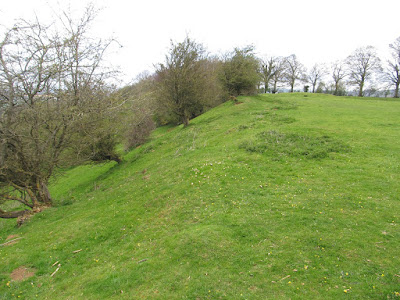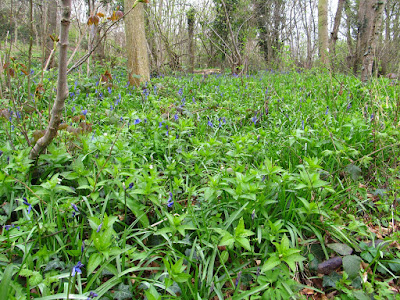Saturday 10th April 2021
Since there were still restrictions on travel at this time I decided that for the last day of my holiday I would visit Pitsford Water in Northamptonshire, which is a place I have visited several times, but not recently. This walk was inspired by the walk I did on my first visit to the area many years ago parking at the Spratton Road crossing on the Brampton Valley Way, which runs along the old track bed of the Northampton to Market Harborough Railway. Heading south from the car park I had a pleasant stroll along the old railway line and reflected that I really must spend more time in future exploring the Brampton Valley Way and maybe even walking the whole route from Market Harborough to Northampton. I had a lovely walk at this point filled with birdsong past blackthorn hedges that were covered in white flowers and contrasted sharply against the grey, overcast skies. When I eventually reached Merry Tom Crossing I turned left off the trail onto a track that climbs out of the valley to the main road that comes out of Brixworth and after crossing the road entered the grounds of Pitsford Water. By the time I reached the reservoir it had started raining and this would continue for a long time.
Under miserable weather, but with a clear path under foot, I walked along the perimeter path and had a relaxing, straightforward walk with little undulation, but with few trees to alleviate the scenery, which does not compare well with other reservoirs that have dense woodland all around their shores, and I felt this lack of wild scenery. To be fair to the reservoir, the eastern half is heavily wooded and must be a great place to walk, but access is restricted as a nature reserve, though I would love to purchase a permit that would allow me to explore this wilder scenery, but sadly that was not on this occasion. When I reached the causeway the rain had finally begun to ease, which was a great comfort as it is always much nicer to walk when it is not raining. After crossing the causeway I turned back towards Brixworth enjoying the walk along the northern shore as the weather slowly improved along with the terrain. When I reached the woodland landscape of Brixworth Country Park I turned away from the reservoir to do a walk around the more pleasing terrain that is in park rather than elsewhere around the reservoir, but is unfortunately too small, though I have a fond memory of a previous visit finding there long grass that was alive with the sound of chirping insects.
Unfortunately this was the wrong time of the year, though when the sun came out I was prompted to nip back down to the shore to take some pictures, but soon I was climbing back through the country park onto a footpath that leaves the reservoir and enters the village of Brixworth. When I did this walk many years ago I headed straight from Brixworth onto Spratton Road back to the car park, but this road is steep and narrow so is not safe to walk on. This time I decided to take an alternative route passing through the interesting village of Brixworth past the Anglo-Saxon church of All Saints onto a footpath that took me down to the site of Brixworth railway station on the Brampton Valley Way where I turned south again and had a pleasurable walk back to the Spratton Road crossing. This was an enjoyable walk despite the poor weather, though helped by the improvement in the weather. It had been a long time since I had been to Pitsford Water and I was surprised to see how popular it was with many people jogging along the perimeter path, though I was disappointed at the lack of interesting scenery along the southern shore of the reservoir. The Brampton Valley Way, was a lovely place and I really must find a way to walk along more of this disused railway line.






